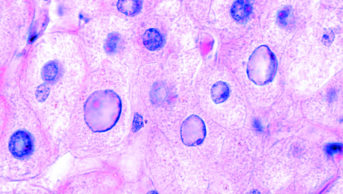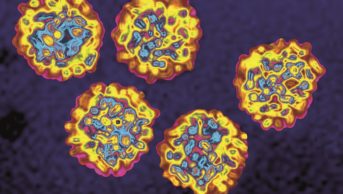
Shutterstock.com
After reading this article, you should be able to:
- Recognise when liver function tests (LFTs) are indicated;
- Understand how to interpret the results of LFTs;
- Identify common patterns of LFT abnormality and next steps.
In the UK, more than 40 people die each day from liver disease — this represents a 400% increase since 1970[1]. While the prevalence of heart disease and cancer have remained stable or decreased, rates of liver disease have continued to increase in correlation with rising alcohol consumption over the past three decades. Liver disease is the third leading cause of premature death in the UK and the leading cause of death in those aged 35–49 years[1,2]. Symptoms include jaundice and fatigue; however, the disease can be completely asymptomatic and healthcare professionals are increasingly likely to encounter patients with varying disease severity[1].
Liver function tests (LFTs) are ordered when a healthcare professional suspects a new diagnosis of liver injury, worsening of a diagnosed condition, such as new onset confusion, drug-induce liver injury (DILI) or to monitor the progression of a liver disease[3].
LFTs are now referred to as liver blood tests when counselling a patient, as there may not be any impairment to function, making it a more accurate description[4]. LFTs are not used in isolation to diagnose specific conditions but in conjunction with past medical history, the presence of other signs and symptoms of liver disease such as ascites, jaundice, worsening cognitive function or a bleed, and any relevant scans or biopsies.
The role of the pharmacist in assessing and utilising these tests will vary depending on the reason for review and the setting within which the patient is seen. For example, pharmacists running clinics for patients post liver transplant or working in GP surgeries may be required to understand the specific LFTs to order them and how to interpret results depending on the presentation of the patient. This will be different to a pharmacist working in a community pharmacy or on a ward setting, where they may not order the test but will need to interpret the results to understand the severity of the liver disease or make decisions on the pharmaceutical management of the patient. In some cases, the pharmacist may be in a position where they need to communicate LFT results to patients, please see Box for how this can be approached.
This article will highlight the role of each LFT and outline their indications, with the aim of supporting the pharmacist’s understanding of how to use and interpret these tests in practice.
The liver and disease
The liver has a wide variety of functions — these include but are not limited to protein synthesis, synthesis of clotting factors, conversion of excess glucose to glycogen and absorption of fat-soluble vitamins. Monitoring these parameters can indicate the function of the liver; however, this is not routinely carried out in primary care[5].
When interpreting LFTs, it is important to consider the patient’s disease state — for example, they may have acute liver failure (ALF) or chronic disease manifesting itself as compensated or decompensated cirrhosis (i.e. scarring of the liver). Liver disease with a duration of greater than 28 weeks before the onset of hepatic encephalopathy (HE) — a decline in brain function seen in advanced liver disease — is termed chronic liver disease[6]. Chronic insult to the liver initially results in the deposition of fat in the hepatocytes, then the development of fibrosis (i.e. scar tissue with collagen deposits). Severe fibrosis from continual insult results in compensated or decompensated cirrhosis[5].
The compensated stage of cirrhosis is asymptomatic; however, decompensated cirrhosis involves an acute deterioration in liver function in a patient with cirrhosis and is characterised by jaundice, ascites, HE, hepatorenal syndrome or variceal haemorrhage[7]. Common precipitants of hepatic decompensation include infections, gastrointestinal bleeding, high alcohol intake or DILI, although no specific cause is found in around 50% of cases. It is important to determine the underlying cause of hepatic decompensation through careful history taking, examination and investigations so that appropriate treatment can be identified[8].
Hemochromatosis, a condition where the body stores excess iron, can result in liver damage. Iron overload can also be found in cases of excess alcohol consumption, non-alcoholic fatty liver disease and other chronic liver diseases. When encountered, it should be considered in the context of liver disease[9].
Some additional considerations that should be made when reviewing a patient with liver disease are shown in Table 1.
![Table 1: Considerations to be made when reviewing a patient with liver disease[10,11]](https://pharmaceutical-journal.com/wp-content/uploads/2022/02/Table-1-Considerations-WM.png)
Diagnostic testing
Traditionally, LFTs include alanine aminotransferase (ALT), alkaline phosphatase (ALP), aspartate aminotransferase (AST), bilirubin, and gamma-glutamyl transferase (GGT), and are ideally collected as a serum sample. A full blood count, international normalised ratio (INR) and albumin levels are also measured to assess the liver’s function[9].
Many of these tests are not specific to the liver and therefore must be used in combination with clinical examination and a thorough patient history, including body mass index. If abnormal LFT ranges are identified, additional investigations are required. This will often involve an ultrasound and a liver aetiology screen, which is informed by the pattern of abnormality and is described in more detail below[9]. It is important to review trends in LFTs rather than individual markers to help distinguish if there is true liver impairment or a change in function.
The liver has many functions, including the production of clotting factors and glycaemic control; therefore, review of a patient’s INR and glucose control can be indicative of the liver’s ability to function normally. Glucose control is often monitored as a marker of liver function for hospitalised patients[12].
Patients with liver damage may have LFTs that are within reference ranges owing to low severity of insult or hepatocyte necrosis, which is found in the context of chronic liver disease and may result in reduced liver enzyme synthesis[5]. Therefore, isolated values cannot be used to describe the current function of the liver. When assessing LFTs it is important to consider the following points:
- Reference ranges can vary between specific laboratories — local guidance should be consulted when interpreting results. For this reason, no LFT reference ranges are given in this article;
- If a patient has liver dysfunction, it is likely that more than one LFT result will be abnormal;
- All of the LFTs results can be altered by non-liver-related injury/disease or by certain medications (e.g. statins, acetaminophen), this is further explained below;
- Do not use LFTs as isolated results but as trends over time, depending on whether the injury is acute or chronic[5].
Liver function tests
Transaminases
Transaminases in the hepatocytes are involved in the production of various amino acids. Hepatocytes release the enzymes ALT and AST when they are damaged or injured by alcohol, a virus or in non-alcoholic fatty liver disease[5].
AST is not only found in the liver but also the heart, skeletal muscle, pancreas, lung, kidney and red blood cells. Although ALT is found in other organs, it is produced in much larger quantities in the liver and is therefore described as a liver-specific enzyme[5].
Conditions such as acute cardiac muscle damage and liver cell hypoxia will increase both AST and ALT[5].
Within the context of the patient’s presenting symptoms and history, the level of increase in AST and ALT can indicate the cause of liver injury, for example:
- In fatty liver disease, AST and ALT are likely to be >3x the normal upper limit of normal (ULN);
- In most cases of liver dysfunction, there is more likely to be a greater increase in ALT; however, an AST:ALT ratio of at least 2:1 with a GGT >2 x ULN can support the diagnosis for alcoholic hepatitis;
- Increases of AST and ALT >15 x ULN are often seen in acute hepatitis or hepatotoxicity, such as with a paracetamol overdose owing to massive hepatocyte death or damage;
- Where hepatocyte mass is markedly reduced in chronic disease, AST and ALT levels may appear normal owing to the reduced number of hepatocytes releasing the enzymes[5,12].
Bilirubin
Bilirubin is produced by the breakdown of red blood cells in the liver, spleen and bone marrow. Unconjugated bilirubin, attached to albumin, is transported in serum to the liver; it is insoluble in water and therefore cannot be excreted[5]. Hepatocytes transform the unconjugated bilirubin into conjugated bilirubin, which is water-soluble and excreted via bile into the intestine[5]. In adults, serum bilirubin >50micromol/L is termed clinical jaundice[12].
A total bilirubin test incorporates both conjugated and unconjugated bilirubin. This information can be used to assist diagnosis; for example, if the fraction of conjugated bilirubin is high, this can indicate obstructive jaundice, and a high unconjugated fraction can indicate haemolytic anaemia, such as sickle cell disease, and congenital hyperbilirubinaemias, such as Gilbert’s syndrome. In haemolytic anaemias, the rate of red cell destruction is greater than the liver’s ability to conjugate the bilirubin and the body is unable to excrete it[5].
Bilirubin may also be raised in cholestasis (i.e. decreased bile flow), alongside the biliary tract enzymes ALP and GGT. It can also be raised in acute liver injury owing to the damaged hepatocytes’ inability to conjugate and excrete bilirubin[12].
Some healthcare centres will split the two types of bilirubin when testing, giving just the conjugated bilirubin value[12].
Alkaline phosphatase
Serum ALP is a group of isoenzymes that are found in the liver, bone, kidney, intestine and placenta; therefore, it must be considered within the clinical context of the patient when making a diagnosis[5]. Hepatic ALP is produced by cells that make up the biliary epithelium, its production is increased when the biliary tract is damaged, caused by obstruction or cholestasis in conditions such as primary biliary cholangitis[5].
A raised GGT level alongside raised ALP can support a diagnosis of hepatobiliary origin, such as cholestasis. Damage to the biliary tract can be intra- or extra-hepatic; caused by drugs (e.g. erythromycin and phenytoin) or tumours, which can increase the ALP to greater than ten times the ULN, or gallstones, which cause an increase of up to three times the ULN[5]. In hepatic injury, ALP can be normal or slightly raised, depending on the degree of injury[12].
Other causes of raised ALP include Paget’s disease (a bone disease), where ALP can range from normal to ten times the ULN depending on the severity of the disease[5]. During the final trimester of pregnancy, ALP can be up to three times the ULN and remain raised for several months post-delivery[5].
Gamma-glutamyl transferase
GGT is an enzyme found in the hepatocytes and biliary epithelial cells, as well as in the kidney, pancreas, intestine and prostate. GGT has a role in drug metabolism and is raised in all forms of liver injury or dysfunction; therefore, it is not used in isolation to differentiate between conditions. However, an isolated rise in ALP and GGT 10–20 x ULN can indicate cholestasis[9].
An isolated increase in GGT can be associated with increased alcohol consumption and can be used to diagnose alcoholic liver disease. GGT levels in alcoholic liver disease can vary between individuals, from being within normal ranges to >20 x ULN. It is important to note that, on withdrawing from alcohol, resolution of GGT levels takes around two to five weeks; however, a continually raised GGT does not necessarily indicate continued alcohol abuse[5].
GGT may be raised in individuals taking enzyme-inducing drugs, such as phenytoin or rifampicin[5].
Albumin
The liver produces the protein albumin; it is an indicator of the synthetic function of the liver, meaning it can be indicative of the liver’s ability to synthesise various products[9]. In ALF, an initial reduction of albumin may not be seen owing to its long half-life — albumin has a half-life of around 20 days; therefore, a low level implies chronic disease[13].
As with all LFTs, albumin levels need to be reviewed in the context of the patient’s clinical condition, as low albumin may not always indicate liver disease. Patients who are malnourished, have malignancy, inflammatory bowel disease or nephrotic syndrome may have low levels of albumin, as well as those who are critically unwell or who have traumatic injuries, owing to protein insufficiencies[5,12,14].
Coagulation tests
Prothrombin time
Produced by the liver, prothrombin is a vitamin-K dependent clotting factor. Prothrombin time (PT [reference range 12–16 seconds]) is the time it takes for a clot to form in a blood sample, and is often monitored in patients taking anticoagulants to assess bleeding risk. Reduced intake or reduced absorption of all fat-soluble vitamins, including vitamin K, and severe liver injury will reduce the overall production of prothrombin and increase the time it takes for a blood clot to form[5,9]. If a PT that is prolonged in isolation (i.e. in the absence of other abnormal test results) reduces within 12–24 hours of intravenous administration of vitamin K, then the prolonged PT can be explained by vitamin K deficiency[15]. However, if after several doses of vitamin K, no change is seen, then the coagulopathy is likely related to reduced synthesis of clotting factors in the liver. Review of PT has largely been replaced by INR, which is a more accurate method of comparing clotting across laboratories, where variations can occur[5].
International normalised ratio
INR (reference range 0.9–1.2) is the PT expressed as a ratio in comparison to a control value, which is derived by the laboratory. In chronic disease, the INR may increase over a period of weeks or months to values greater than 2.5 as the liver decompensates[5].
Patterns of liver function test abnormality
The LFT results can indicate the pattern of injury. Liver disease is classified according to both the pattern of damage seen and the time course over which the damage occurs. The pattern of damage can initially be classified as cholestatic, hepatocellular or infiltrative, although these can overlap[16].
Hepatocellular
The hepatocellular pattern of injury is marked by isolated or a greater rise in transaminases, as seen in Table 2.
If hepatocellular damage is suspected, additional investigations are required. This includes a liver aetiology screen for hepatitis B and C, to test for viral hepatitis; autoantibodies and immunoglobulins, for autoimmune disease; ferritin and transferrin saturation, for iron overload; and HBA1c to assess metabolic risk[9]. The results of these tests will help guide onward referral. A thorough history must be completed to identify common causes of hepatocellular damage, such as alcohol abuse, hepatitis B or C virus, coeliac disease, hemochromatosis, non-alcoholic steatohepatitis or use of medications, such as azathioprine[16]. Detection of any of these conditions warrants a referral to a specialist clinician/centre. Stopping causative agents, such as medication or alcohol, should be considered; however, this should be managed by the appropriate specialist.
![Table 2: Hepatocellular pattern[3,9]](https://pharmaceutical-journal.com/wp-content/uploads/2022/01/Table-2-liver-function-tests.png)
Cholestatic and infiltrative
There are elevated levels of substances excreted via the bile duct and liver enzymes of the biliary tract in cholestatic and infiltrative patterns of damage, as seen in Table 3. Cholestatic patterns of injury can occur in primary biliary cholangitis and infiltrative patterns can be seen with hepatic cancers. Substantive increases in conjugated bilirubin found in cholestatic diseases can further differentiate between cholestatic and infiltrative patterns[5].
If a cholestatic pattern is seen, additional investigations should be conducted, including a liver aetiology screen, covering autoantibodies and immunoglobulins, and ferritin and transferrin saturation[9].
In cases of suspected malignancy, urgent referral to secondary care is advised[9].
![Table 3: Cholestatic and infiltrative patterns[3,9]](https://pharmaceutical-journal.com/wp-content/uploads/2022/01/Table-3-Liver-function-tests.png)
Drug-induced liver injury
Abnormal bilirubin and hepatic enzymes can also be the result of DILI, which is not diagnosed solely based on LFTs, but through a process of eliminating other causes of liver dysfunction, such as an exclusion of viral hepatitis or alcoholic hepatitis[17]. Drugs that result in hepatocellular damage (e.g. acetaminophen) may cause an ALT rise greater than two times the ULN and an ALT:ALP ratio that is equal to or greater than five times the ULN. There is often a worse prognosis associated with hepatocellular damage in cases of DILI. Medications that cause cholestatic injury (e.g. sulfonamides) may cause an ALP rise that is greater than two times the ULN and an ALT:ALP ratio that is equal to or greater than two times the ULN. In many cases, there will be a mixed picture, where ALT is greater than two times the ULN and ALT:ALP ration is between two to five times the ULN, and where additional investigations, such as biopsies, are required[17].
Box: Communicating results to patients
It is important to explain to the patient/family why the liver blood test is being carried out and the importance of attending blood monitoring appointments to ensure they are fully aware of the investigation and why it is required. Information should be provided using appropriate terminology that the patient/family will understand[18].
An accurate time frame of when the results will be available should be provided.
A description of what the tests reflect and patterns in trends over a period of time should be explained to the patient.
The patient should be informed if they are being referred to a specialist centre, if this has not already happened.
If further investigations are necessary, such as ultrasound scans, fibroscans or liver biopsies, this should be described to the patient along with why the investigation is being carried out.
All findings should be explained to the patient regardless of whether they are abnormal, or normal and warrant no further action[19].
- This article was amended on 2 February 2022 to clarify the wording in Table 1
- 1Statistics — liver disease crisis. British Liver Trust. 2021.https://britishlivertrust.org.uk/about-us/media-centre/statistics/ (accessed Jan 2022).
- 2Williams R, Aspinall R, Bellis M, et al. Addressing liver disease in the UK: a blueprint for attaining excellence in health care and reducing premature mortality from lifestyle issues of excess consumption of alcohol, obesity, and viral hepatitis. The Lancet. 2014;384:1953–97. doi:10.1016/s0140-6736(14)61838-9
- 3Kwo PY, Cohen SM, Lim JK. ACG Clinical Guideline: Evaluation of Abnormal Liver Chemistries. American Journal of Gastroenterology. 2017;112:18–35. doi:10.1038/ajg.2016.517
- 4Liver blood tests (formally known as liver function tests – LFTs). British Liver Trust. 2020.https://britishlivertrust.org.uk/information-and-support/living-with-a-liver-condition/liver-blood-tests/ (accessed Jan 2022).
- 5Hughes C. Assessing liver function. In: North-Lewis P, ed. Drugs and the liver. London: : Pharmaceutical Press 2011. 16–99.
- 6Wendon J, Cordoba J, Dhawan A, et al. EASL Clinical Practical Guidelines on the management of acute (fulminant) liver failure. Journal of Hepatology. 2017;66:1047–81. doi:10.1016/j.jhep.2016.12.003
- 7Angeli P, Bernardi M, Villanueva C, et al. EASL Clinical Practice Guidelines for the management of patients with decompensated cirrhosis. Journal of Hepatology. 2018;69:406–60. doi:10.1016/j.jhep.2018.03.024
- 8Mansour D, McPherson S. Management of decompensated cirrhosis. Clin Med. 2018;18:s60–5. doi:10.7861/clinmedicine.18-2-s60
- 9Newsome PN, Cramb R, Davison SM, et al. Guidelines on the management of abnormal liver blood tests. Gut. 2017;67:6–19. doi:10.1136/gutjnl-2017-314924
- 10British National Formulary (online). Joint Formulary Comittee. 2021.http://www.medicinescomplete.com (accessed Jan 2022).
- 11Andrade RJ, Aithal GP, Björnsson ES, et al. EASL Clinical Practice Guidelines: Drug-induced liver injury. Journal of Hepatology. 2019;70:1222–61. doi:10.1016/j.jhep.2019.02.014
- 12Yap CY, Aw TC. Liver Function Tests (LFTs). Proceedings of Singapore Healthcare. 2010;19:80–2. doi:10.1177/201010581001900113
- 13Dufour D, Lott J, Nolte F, et al. Diagnosis and monitoring of hepatic injury. I. Performance characteristics of laboratory tests. Clin Chem 2000;46:2027–49.https://www.ncbi.nlm.nih.gov/pubmed/11106349
- 14Nicholson JP, Wolmarans MR, Park GR. The role of albumin in critical illness. British Journal of Anaesthesia. 2000;85:599–610. doi:10.1093/bja/85.4.599
- 15Thachil J. Dispelling myths about coagulation abnormalities in internal medicine. Clin Med. 2014;14:239–44. doi:10.7861/clinmedicine.14-3-239
- 16Musana KA, Yale SH, Abdulkarim AS. Tests of Liver Injury. Clinical Medicine & Research. 2004;2:129–31. doi:10.3121/cmr.2.2.129
- 17David S, Hamilton J. Drug-induced Liver Injury. US Gastroenterol Hepatol Rev 2010;6:73–80.https://www.ncbi.nlm.nih.gov/pubmed/21874146
- 18Standards for the communication of patient diagnostic test results on discharge from hospital. NHS England. 2016.https://www.england.nhs.uk/patientsafety/wp-content/uploads/sites/32/2016/03/discharge-standards-march-16.pdf (accessed Jan 2022).
- 19Dahm MR, Georgiou A, Westbrook JI, et al. Delivering safe and effective test-result communication, management and follow-up: a mixed-methods study protocol. BMJ Open. 2018;8:e020235. doi:10.1136/bmjopen-2017-020235


